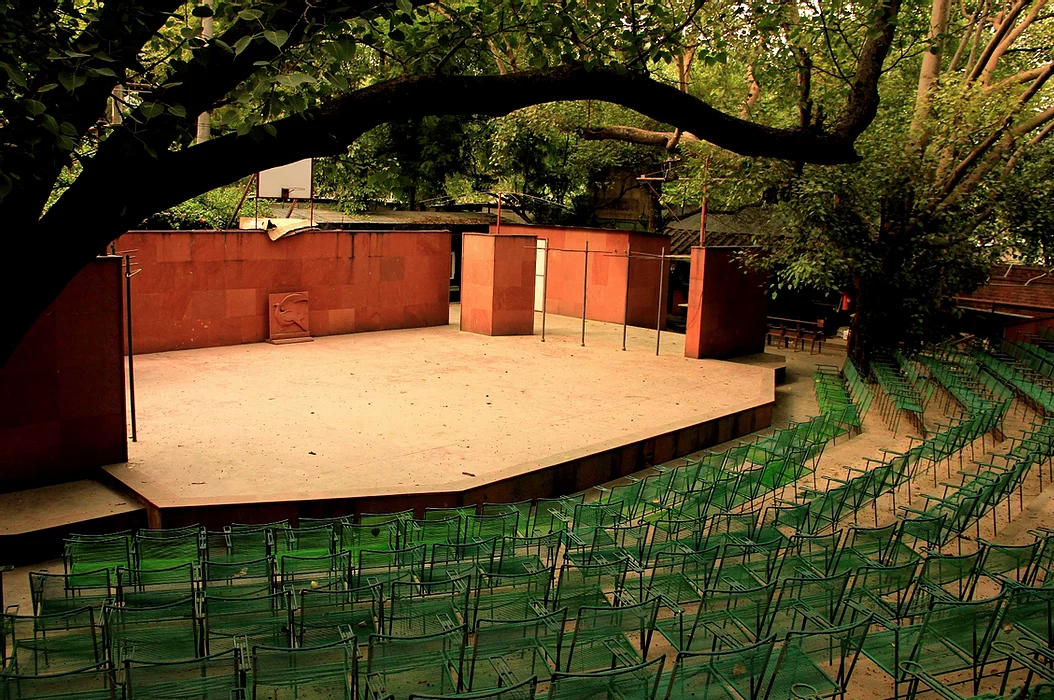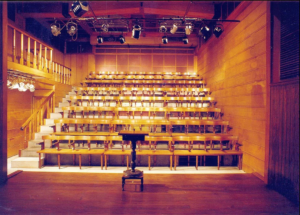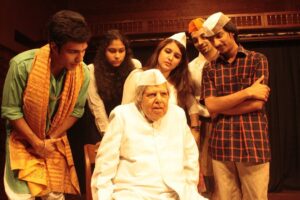Indian thespians pushed out of the limelight by Covid-19 pandemic

The Pipal Tree theatre, crafted in pink sandstone, is the outdoor theatre space of Akshara Theatre (Photo: Akshara Theatre)
India is renowned for having one of the most popular and prolific movie industries. According to the American Enterprise Institute, Bollywood surpasses Hollywood in terms of number of movies and moviegoers (1000 movies a year watched by an estimated 3 billion people worldwide). Theatre, however, is significantly more popular in the West, with Broadway shows in the 2017/2018 bringing in around USD 1.7 billion.
Although theatre in India started in 15th century BC, and modern Indian theatre has been present since the British Raj, today it struggles to compete with India’s multi-billion-dollar film industry. The chief trait that sets it apart from films is the exhilaration of live performances.
Kush Jobanputra has been involved with the Rangshila Theatre Group for more than seven years. Established in 2008, Rangshila has presented plays at India’s top theatre festivals, such as at the National School of Drama and Bharat Rang Mahotsav.
“The greatest difference between the camera medium and theatre medium is that on stage, the actor is more powerful because he is connecting with the audience directly – there’s no cut, camera, action, zoom in or zoom out. There is no director or anyone to cut in when something goes wrong; as they say, the show must go on,” Kush tells Media India Group.
In a country that often values pursuing traditional Science, Technology, Engineering and Mathematics (STEM) careers over achievement in the arts, theatre is an escape. Piyush Jain and Prerna Arora started acting with a small group of amateurs. Now, they are both part of the prestigious Akshara Theatre in New Delhi, which was founded in 1972. The company’s most recognised production, a dramatic version of The Ramayana by Gopal Sharman, was commissioned by The Royal Shakespeare Company.
“Theatre happened quite by accident for me. I was really bored with the 9-5 grind and needed a space that was different from what I was doing everyday,” Jain tells Media India Group. Since then he has acted in plays such as 12 Angry Men and We are Citizen India.
Jain is apprehensive about the fate of theatre in India, and does not truly think the scene has thrived as it should.
“The theatre industry is shrinking. Independent theatre groups have mushroomed across India over the past few years, but the issue is more about sustainability rather than quantity,” says Jain.
Regardless of the talent and effort, with a ticket price of around INR 250-500 and a smaller audience at a limited number of shows, production quality can suffer since theatre companies don’t invest more in the production than they may get in return.
“The budgets for movies run in millions, so they can staff more people with specialised skills. Theatre is the polar opposite, and in fact is dwindling to the point where one-person productions are far more sustainable,” he adds.
For Arora, a lawyer by profession, performing had always been in her blood. “Theatre and dance are both wonderful forms of self expression; they give you inner power and strength,” she explains. Despite the streaming boom and tough competition that platforms like Netflix and Disney bring, Arora believes in theatre’s unique grasp and dependence on human emotion.
“Being a lawyer in the entertainment industry, I have personally observed how these platforms have made content more accessible and in this fast-paced world, it has allowed people to connect with global content from anywhere. However, theatre is a more of an experience. Theatre has a much deeper connection with its loyalists. The idea was never to compete with Bollywood,” she tells Media India Group.
Adapting to survive: A shift to online performances
Unfortunately, even if the theatre industry was steadily expanding, the Covid-19 pandemic has firmly brought all progress to a standstill. It took away the trump card – a live audience.
Since the end of April, when Covid’s second wave was sweeping across India and lockdown restarted, Jain lost his job at Akshara Theatre. He has his own art studio called Art Adventures Studio, where he makes art prints and commissions for paintings.
“I must confess that continuing to act during the lockdowns has been nothing short of a challenge and often a heartbreak,” says Jain. “As far as the salaries go, they have been sparse at best, if at all. Since we are not able to perform, much of the supporting staff around the production has also been out of work, so it’s a domino effect,” he says.
However, in order to survive some theatre groups have begun performing online through platforms like Zoom.
Arora, who grew up watching Pakistani plays, is very familiar with this medium, and while she acknowledges that it won’t be the same, the joy that live acting brings is not lost.
“I never visited Pakistan but I knew those characters. I laughed and cried with them and the spontaneity was spot on,” she says.
Hope for the future

The Indoor Theatre at Akshar Theatre is made of teak and deodar wood, and seats 96 (Photo: Akshara Theatre)
Jain says that just like Netflix and Amazon have taken the OTT series up a notch, they can also add technology to theatre.
“The moment you record a play on a camera, it ceases to be theatre. The closest anything online can come is when a play is shot using a VR camera and watched in 3D on a VR set, which is expensive, but if giants like Netflix and Amazon become pioneers, they can take the theatre industry out of its current state of tatters into a more prosperous, sustainable and better future,” he says.
Once the situation stabilises, theatre artists across India hope that people’s love for the craft will shine through.
“Towards the end of 2020, when things were starting to get normal, we were doing shows with at 50 pc capacity, with social distancing and every available seat in every show was booked,” says Jobanputra. “Right now, everyone is feeling so caged, constantly glued to a screen, and I think people would want a relief from that,” he adds.
Since artists fall under the informal sector, which is often not accounted for in budgets or Covid relief, it is left to the actors and production staff themselves to try and hold on. Last year during lockdown, Akshara Theatre started an initiative called ‘Save The Stage’, but weren’t able to receive immediate financial help. They also shared a proposal with various government officials and started a petition detailing measures to keep the industry afloat.
“Drama schools such as NSD come under the Ministry of Culture, who should work towards preservation of art and artists in these trying times,” says Arora. “Theatre forms a very important part of India’s history and has donned various hats such as nukkad nataks (street plays) for awareness programmes, protests, radio plays for villages, and is a vessel for the cultural depiction of Indian Heritage. It has a right of preservation and conservation.”










